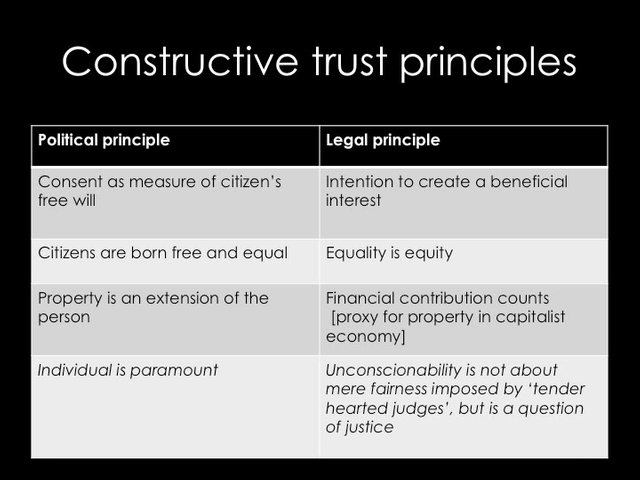Legal Rulings in Determining What Is A Constructive Trust in Equity Disputes
Wiki Article
Unveiling the Benefits of a Constructive Depend On in Handling Recipient Conflicts
The idea of a positive count on arises as a pivotal device in the detailed realm of recipient problems, offering a nuanced option to disagreements that frequently develop from wrongful residential property retention. By fostering a fiduciary relationship between parties, this equitable treatment not just facilitates quick resolutions however additionally offers to deter prospective misbehavior. As we discover the complex benefits of constructive counts on, one may begin to examine exactly how these devices can improve the landscape of estate disagreements and add to a more equitable distribution of assets among beneficiaries.Definition of Constructive Count On
A useful count on is often established by courts to attend to situations where one party has wrongfully obtained or retained residential or commercial property that rightfully belongs to another (What Is A Constructive Trust). This lawful principle is not a typical trust fund, as it does not need the rules usually related to count on creation, such as a written arrangement or the purpose of the celebrations included. Instead, a positive depend on develops by operation of law, working as an equitable remedy to stop unjustified enrichmentThe courts enforce a constructive trust fund when it is figured out that one party holds building under scenarios that, in equity and excellent principles, ought to not permit them to retain it. Usual circumstances include illegal activities, breaches of fiduciary duty, or circumstances where a party has obtained home with incorrect means. The positive trust therefore operates to secure the rights of the rightful proprietor by ensuring that the home is held for their advantage.
Once established, the positive count on needs the event in belongings of the building to convey it to the rightful owner, hence rectifying the wrongful circumstance. This system emphasizes the legal system's commitment to fairness and justice in building disputes, emphasizing the value of moral conduct in possession and transfer of assets.
Benefits of Useful Counts On
Useful trust funds offer several significant benefits in legal conflicts involving property rights. Mainly, they serve as an equitable treatment, enabling courts to deal with circumstances where a celebration has wrongfully obtained or kept home that rightfully belongs to another. This establishes a structure for justness, making sure that the rightful proprietor is compensated and the unjust enrichment of the perpetrator is reduced.Furthermore, constructive trusts can expedite resolution in problems over estate possessions, thus decreasing the commonly contentious and lengthy lawsuits processes related to typical building conflicts. Their flexibility permits courts to tailor remedies to fit the details situations of each case, which can bring about more acceptable end results for all celebrations involved.
Furthermore, constructive depends on promote openness and accountability amongst recipients and fiduciaries, as they call for the last to act in the best rate of interests of the former. This strengthens the integrity of fiduciary connections, fostering depend on and collaboration. Ultimately, by discouraging transgression pertaining to residential property possession, useful depends on add to the general security of legal and economic systems, making certain that residential property rights are respected and upheld within society.
Exactly How Useful Trust Funds Job

In technique, when a useful depend on is imposed, the court identifies the residential or commercial property concerned and establishes a fiduciary partnership in between the celebrations involved. The event that holds the residential property ends up being a trustee, obligated to handle it for the advantage of the try this rightful owner, called the recipient. This connection is not based on an official contract but instead on the principle of equity, intending to remedy circumstances where one event's gain straight correlates with an additional's loss.

Study and Instances
When analyzing the sensible application of constructive counts on, different instance research studies illustrate just how courts navigate complicated circumstances involving unjust enrichment. One noteworthy situation is * Pettkus v. Becker *, where the High Court of copyright established a useful count on to fix the unjustified enrichment of one event over an additional in a lasting partnership. The court identified that the payments of one partner to the purchase of home validated the imposition of a positive count on, guaranteeing fair distribution.One more substantial instance is * Gisborne v. Gisborne *, where the court enforced a positive trust to deal with the insurance claims of siblings over their departed sibling's estate. The court acknowledged the contributions made by the siblings in preserving the household residential property, bring about a choice that needed the estate to represent those contributions, thus avoiding unfair enrichment.
These cases exemplify how positive trust funds can properly settle disagreements by concentrating on fairness and the prevention of unjust enrichment. By analyzing the specific payments and scenarios of the celebrations involved, courts can use positive trust funds to achieve simply results, ultimately enhancing the fair principles underpinning these lawful systems.

Steps to Develop a Positive Depend On
To establish a constructive trust fund, a number of essential actions need to be followed to ensure that the case is corroborated and legally identified. The complaintant should show the existence of a fiduciary partnership or a situation that necessitates the imposition of a useful trust, read the full info here such as scams, unjust enrichment, or a breach of obligation.Second, it is vital to gather and existing compelling evidence that sustains the claim. This includes documents and testimonies that show the conditions resulting in the claimed wrongful retention of home or advantages by the trustee.
Third, the complaintant ought to submit an application in the appropriate court, verbalizing the premises for asking for the charge of a constructive count on. This request has to outline the specifics of the connection and the unfair enrichment that demands the trust fund.
Final Thought
In final thought, positive counts on stand for an important fair remedy in the world of recipient conflicts, properly dealing with wrongful building retention and avoiding unjustified enrichment. Ultimately, useful trust funds promote fairness among recipients, ensuring that rightful ownership is preserved and shielded.
A constructive count on is regularly developed by courts to address circumstances where one celebration has actually wrongfully gotten or retained home that truly belongs to an additional.The courts enforce a constructive trust when it is identified that one celebration holds building under circumstances that, in equity and good conscience, should not permit them to keep it. By dissuading misbehavior associated to building possession, useful depends on add to the general stability of legal and monetary systems, ensuring that residential or commercial property rights are respected and upheld within culture.
In technique, when a useful count on is imposed, the court identifies the property in inquiry and develops a fiduciary connection between the events entailed. What Is A Constructive Trust. The court figured out that the contributions of one companion to the procurement of home validated the charge of a useful count on, ensuring fair distribution
Report this wiki page